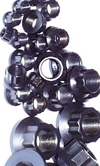Friction
 When we talk about friction in regard to race engines, we are normally referring to the power or energy lost due to it, but the phenomenon of friction plays an important role in the function of many components in a race engine. Fasteners are a particular example.
When we talk about friction in regard to race engines, we are normally referring to the power or energy lost due to it, but the phenomenon of friction plays an important role in the function of many components in a race engine. Fasteners are a particular example.
For critical applications, we would ideally like to measure the tension in a fastener directly, but this is rarely possible. Our next best method of gauging the tension in a fastener immediately after tightening is to measure its length and compare this to its free length. Given some accurate information regarding the geometry of the fastener and the properties of the material from which it is made, we can calculate the load in the fastener. Unfortunately, this is possible only for fasteners where we can access both ends to make measurements using a 'stretch gauge' or in fasteners large enough to incorporate measurement features.
For many engine suppliers, the best available method is to specify a tightening torque and calculate the load based on this. The relationship between torque and tension depends on a number of parameters, including the thread flank angle, its pitch, pitch diameter, dimensions of the mating face of the washer/nut/mating face of the bolt as applicable, and the friction at any interfaces. The coefficient of friction is important because the higher it is, the less tension we will achieve in a given bolt for a certain level of torque.
One reason why torque specification for bolt tightening is not the first preference of many engineers is that there is large uncertainty in the level of friction. There are a number of sources of friction coefficients, but in practice the actual level of friction can depend on many factors, including the cleanliness of the components, their surface finish, whether the joint has been 'preconditioned' by previous use, and the type and amount of lubricant used.
The friction coefficient also has an effect on the level of stress within the bolt, both during and after tightening. As we know, when we tighten a fastener we induce a level of twist in the shank and threads, which is proportional to the torque used. From our physics and engineering classes we know that the angle of twist is proportional to the applied torque. The shear stress due to torsion is also proportional to the applied torque. The torque involved in twisting the bolt is proportional to the coefficient of friction, and therefore we can see that the shear stress - and the combined stress due to shear and tensile stresses - is affected by friction. It is known that a proportion of the shear stress relaxes in the period immediately after tightening, but we still have to consider its effect in yielding the fastener during tightening. There are special methods which can preload fasteners without inducing any torsional shear stresses, but these are generally restricted to larger fasteners than we would find on a racing engine.
Minimising the level of friction and being able to control its consistency is important if we want to have faith that we have achieved the desired level of tension in the fastener. Special lubricants have been developed for this purpose and have been discussed in a previous article.
Fig. 1 - Thread and underhead friction has a critical effect on the torque-tension relationship in fasteners, and also affects the maximum stresses in the fastener (Courtesy of ARP)
Written by Wayne Ward